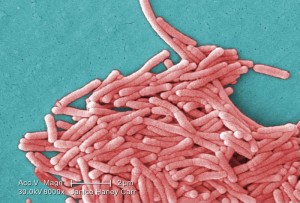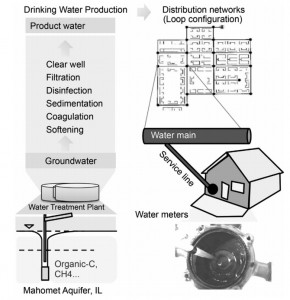While it has long been known that some cyanobacteria move (or crawl) towards light, how these cells detect the direction and source of light was undescribed until recently. In Cyanobacteria use micro-optics to sense light direction, Schuergers et al. (2016) investigated Synechocystis phototaxis and found that each cell acts as a microscopic spherical lens, focusing an intense light spot close to the opposite side …
Set in stone Commentary: Making microbiology of the built environment relevant to design – G. Z. Brown, Jeff Kline, Gwynne Mhuireach, Dale Northcutt and Jason Stenson – Microbiome (OA) Architects are enthusiastic about “bioinformed design” as occupant well-being is a primary measure of architectural success. However, architects are also under mounting pressure to create more sustainable …
A recent paper Dzieciol et al uses 16S pyrosequencing to characterize the bacterial biofilms on floor drains. Listeria monocytogenes was also tested for using both cuture-independent and -dependent techniques. Here is the abstract: Sanitation protocols are applied on a daily basis in food processing facilities to prevent the risk of cross-contamination with spoilage organisms. Floor drain water …
(Update: after posting this I found that actual experts have proposed a different hypothesis) So the recent Legionnaires’ Disease Outbreak in Flint, Michigan has been getting quite a bit of press recently. For example in the last few days here are pieces from The Atlantic, The Washington Post, and CNN. The very short version of …
Here is a new set of papers that came out in the past week(s) that I posted at MicrobiomeDigest, but that I also wanted to share here. Three of these papers are from BMC’s Microbiome journal, which recently has published several other built environment microbiology papers, so it’s worth checking out. Microbes in buildings Moisture …
Here is your song to go with this post: Something in the water by Carrie Underwood. When we drink tap water, we usually don’t really think about the bacteria that might be in there. The quality of drinking water in the US is regulated by Environmental Protection Agency (EPA) and monitored by regularly testing the water …
This study, just published in Infection and Immunity has been getting a lot of press: Some bacteria ‘live for long periods’ on toys, books and cribs Germs that cause colds can last outside human body for months: study Crib toys, day care items can harbor strep bacteria for months The basic gist of this story …
Had to post about this recent paper that came out in PLOS ONE, “Spaceflight Promotes Biofilm Formation by Pseudomonas aeruginosa“. Obviously we’re thinking a lot about bacterial activity in space, apropos of our Project MERCCURI work. Really the title says it all here. Biofilms are awesome. Space is awesome. Turns out that biofilms in space …
Just wrote a post a few minutes ago about the sequencing and analysis of the genome(s) of representatives of the TM6 phylum of bacteria that were found in a hospital sink biofilm: First genome of TM6 — a novel phylum of bacteria — determined from a hospital sink sample. And lo and behold just realized there …
Short post here about a cool-sounding advance in materials science related to microbes in the built environment. A research group at Duke University is working on a material that deforms in response to an electric current, thereby dislodging established biofilms (e.g. on the underside of a boat). Hard to tell how likely this is since …

